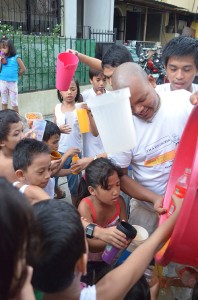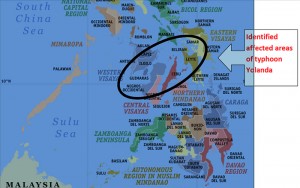 UPDATE – Eight Food for Life volunteers from Manilla left on Nov 11 by land transport to Legaspi city and then took a two-day boat ride to Samar. The delays were due to many other charitable groups all moving in the same direction trying to help out.
UPDATE – Eight Food for Life volunteers from Manilla left on Nov 11 by land transport to Legaspi city and then took a two-day boat ride to Samar. The delays were due to many other charitable groups all moving in the same direction trying to help out.
Volunteer director, Balarama das, explained, “It is very dangerous because people are becoming wild and desperate due to hunger and trauma.” Another group of Food for Life volunteers from Manila are prepared to leave as soon as possible.
Food for Life Emergency Relief Coordinator for the Philippines, Radha Lila said, “Our support team in Manilla are trying to raise funds locally while Food for Life Global, The Lotus Trust and other Filipino people are trying to help us raise abroad.
“The main issue with the relief endeavour is transportation. Our present Food for Life vehicle that we use for our daily feeding in Manila is unreliable for long distance travel.
“I have approached Indian Chamber of Commerce, as they have a connection with the C-130 (Army officials) who has been helping them to transport their collective donations of ready-to-eat-food, however, the director of the Social Charity department informed me that there is currently no transportation available.
“I have also sent a letter of request to the Red Cross to loan us a 6×6 wheeler truck and they approved, but all their trucks have already been deployed 2 days ago. It is desperate times here and transportation is a critical part of a successful relief effort, but so far we are not having much luck.”
The Plans
Food for Life will set up 5 camps in different affected areas to feed 2 meals per day to a minimum of 2500 people in each camp. There will be continuous supply of produce and grains from nearby places not affected by typhoon. We believe the most practical transport in this situation is by helicopter or airlift, with which we can easily transport volunteers and food from one place to another.
“I have a projection of continuous feeding for 3-6 months,” explains Radha Lila.
“We could also rent vehicles in nearby places (not affected by the disaster) to transport the cooked food to most affected places. Volunteers from all over the world are offering to support the effort, including a team from Hungary.”
Help Now
[paypal-donation]
Official Report on Damage
 MANILA, Philippines – In the aftermath of typhoon Yolanda (international codename Haiyan), 5 provinces, 1 city and 6 municipalities have been placed under state of calamity as of Monday, November 11.
MANILA, Philippines – In the aftermath of typhoon Yolanda (international codename Haiyan), 5 provinces, 1 city and 6 municipalities have been placed under state of calamity as of Monday, November 11.
All 5 are in Region VI (Western Visayas):
- Aklan – The Philippine Information Agency (PIA) reported that the declaration was made on Saturday, November 9, during an emergency session of the Sangguniang Panlalawigan (provincial council). A total of 27,583 families or 118,799 inidividuals were affected by the typhoon, said PIA.
- Antique – The northern part of Antique suffered the brunt of the typhoon, provincial board member Edgar Denosta said in a report by state-run Philippine National Agency. At least 2 people in Bugason town were killed by the typhoon.
- Capiz – An initial report by the Provincial Disaster Risk Reduction and Management Council showed that 92,753 families or 385,800 individuals were affected in the province. A second command center for Visayas was set up in Roxas City.
- Iloilo – On Friday, November 8, only 4 municipalities were placed under a state of calamity. The following day, the entire province followed suit. Families were displaced in 12 towns, according to the Provincial Disaster Risk Reduction and Management Council.
- Negros Occidental – Governor Alfredo Marañon Jr said that Yolanda was the worst calamity that hit the province in recent years. Electricity has been down in 9 towns in northern Negros since Friday. At least 23,011 families in 27 of the 31 towns and cities were affected.





